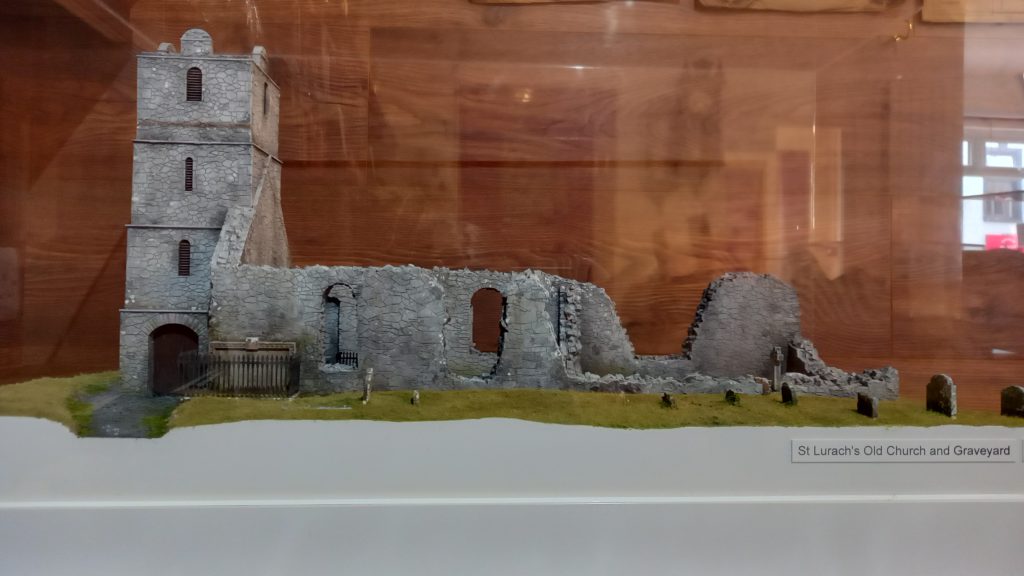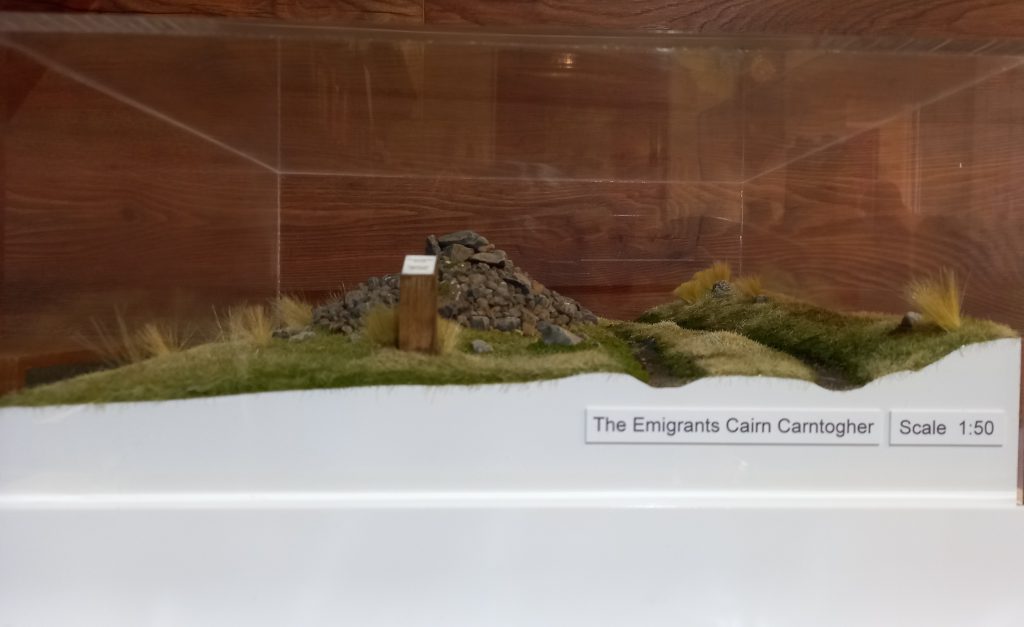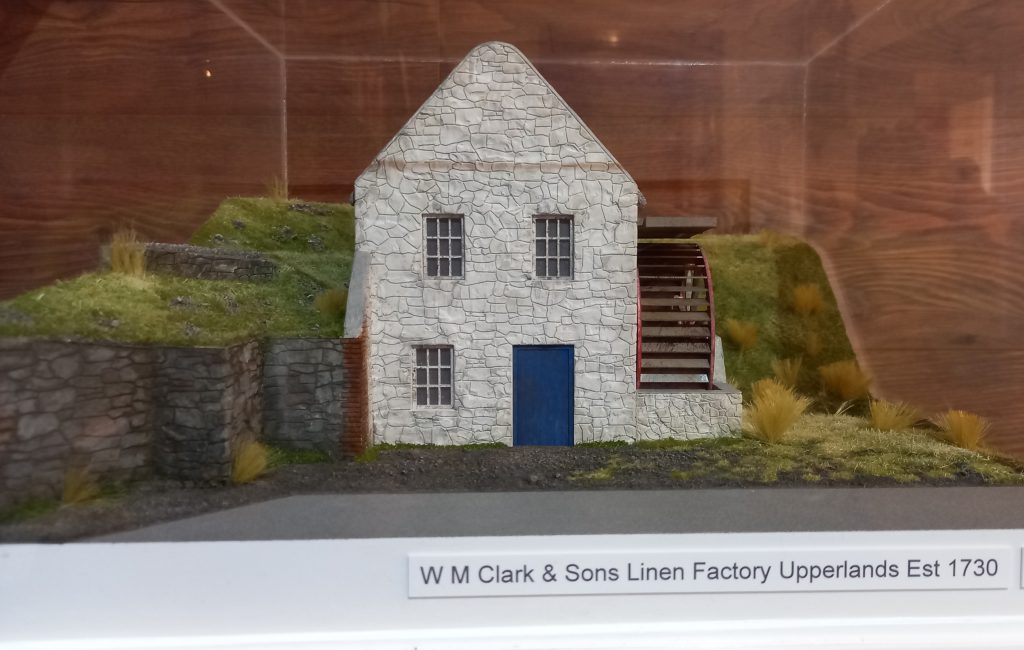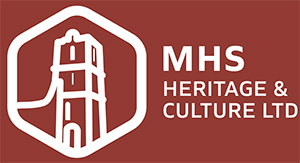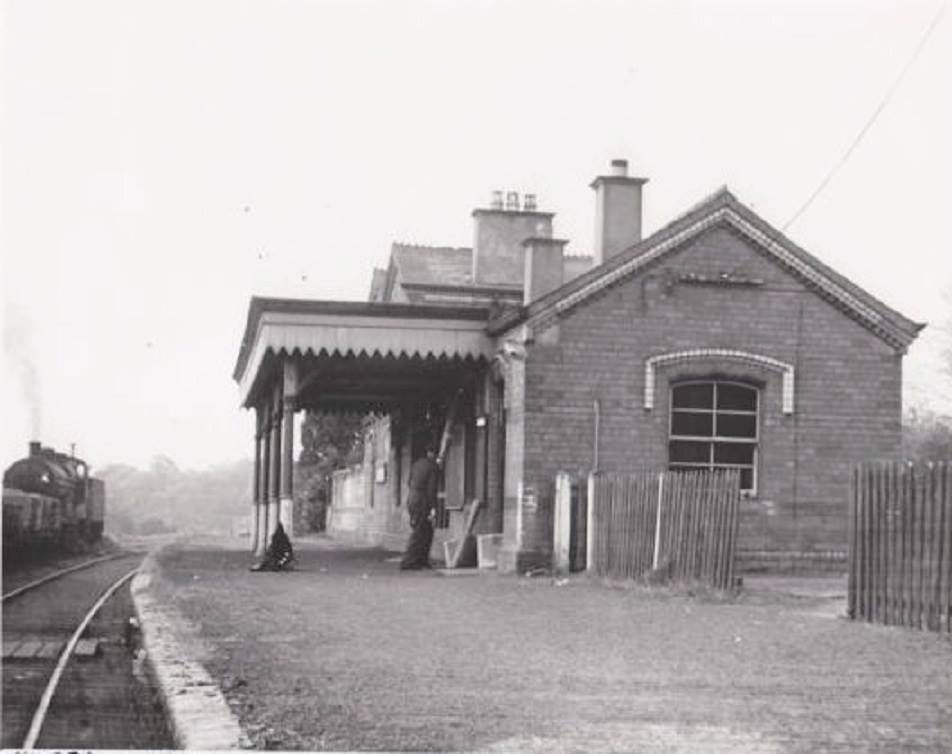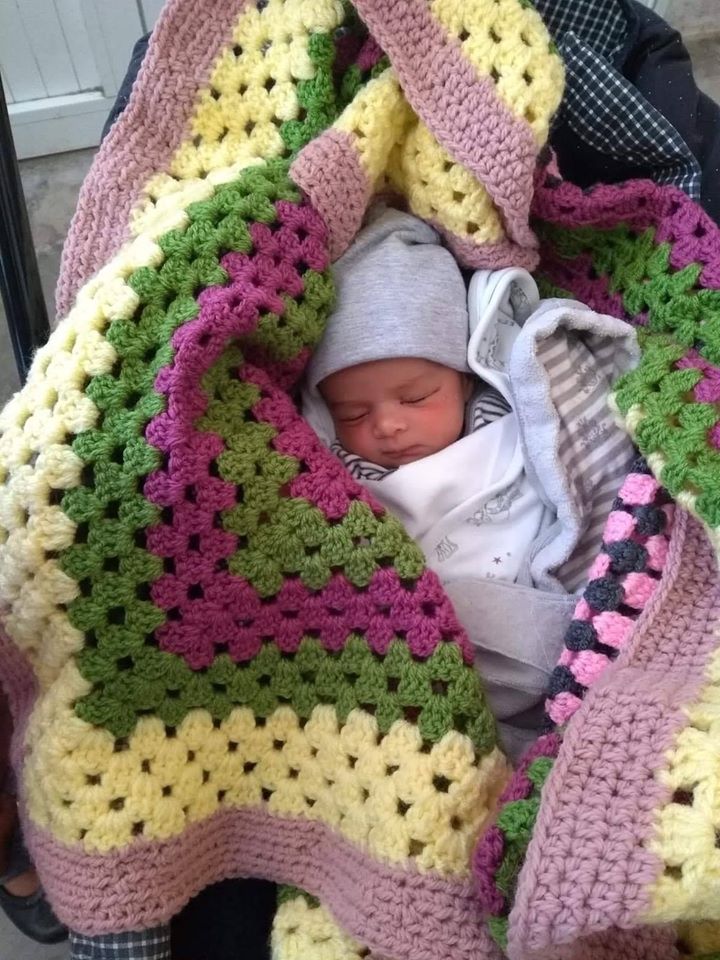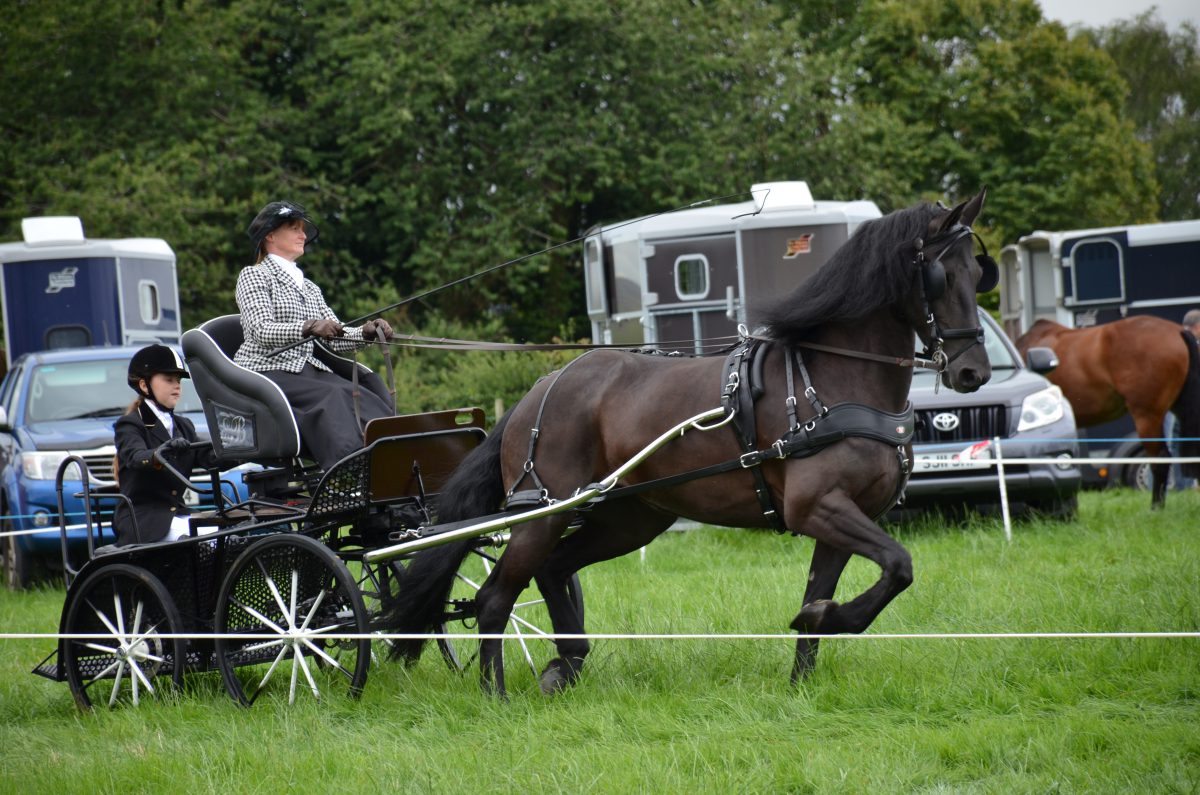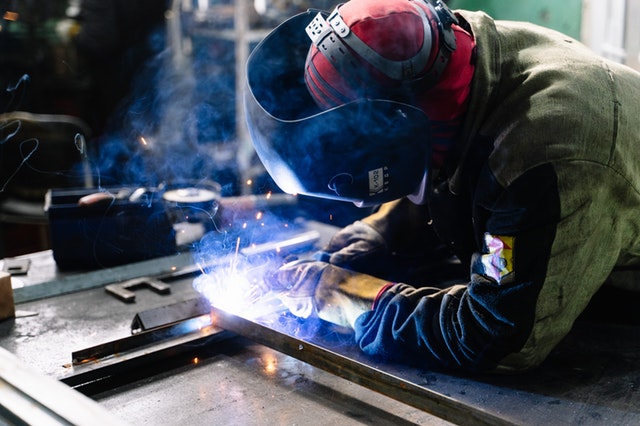MAGHERA RAILWAY CHILDREN IN THE 1950s by Stuart Monteith.
Foreword
During the 79 year existence of the Derry Central Railway (1880 to 1959), Maghera Railway Station played an important role in the economy of the town itself, including its immediate South Derry rural hinterland with the provision of both passenger, freight and livestock transport. It also provided stable long term employment for a core staff of seven personnel, in addition to supporting employment for ancillary personnel, some of whom, were not directly employed by the railway authorities.
Maghera Railway Station first opened for business on 18th December 1880 as one of a number of stations on the Derry Central line which was 29.5 miles in total length, and ran from Magherafelt to Macfin. The other stations/halts on the line were in order – Knockloughrim, Maghera, Upperlands, Tamlaght, Kilrea, Garvagh, Moneycarrie, Aghadowey, Curragh Bridge and Macfin.
The Derry Central Railway was taken over by the Midland Railway and administered by the Northern Counties Committee in September 1901 for the sum of £85,000 and later by the Ulster Transport Authority (UTA) in 1949.
Maghera Railway Station, as well as all other stations on the line, was closed to passenger traffic on 28th August 1950, largely as a result of an improved road network and the availability of motor cars and buses as the primary means of public transport. There was the occasional exception, which I will make reference to later.
During the 79 years of its existence, the Derry Central Railway never made a profit. With the rise of the motor haulage industry in the early 1950’s, it soon became evident that the remaining freight and livestock core business of the Derry Central Railway was also not economically sustainable in the long term.
As a result Maghera Railway Station, along with the other stations on the line, finally closed on 1st October 1959.
Introduction
My name is Stuart Monteith and, in my early childhood I lived in Maghera Station House along with my younger siblings, Sandra and Carl. My father was the last of the five Station Masters to reside there. Prior to moving in 1952, following my father’s appointment, my parents, Sandra and I had previously lived in Tamney Crescent, Maghera. Carl was born the following year and we enjoyed an idyllic childhood in the railway environment until 1961, two years after the station finally closed. My father was subsequently transferred to Magherafelt Station where we again took up residence in the Station House.
Station Staff
Full Time
Herbert Monteith – Station Master
Howard Cunningham – Station Clerk
Tommy Porter- Signalman/Railway Porter
Alex Graham – Lorry Driver (Freight)
Tommy Peden – Lorry Driver (Livestock)
Alex Richardson – Lorry Driver/Helper (Livestock)
Alex McLean – Lorry Helper (Livestock)
Peripatetic Staff
Mattie Harbinson – Engine Driver
Alfie Crawley – Fireman
Matt Bowman – Railway Ganger
George Duncan – Railway Ganger
Jackie Bowman – Railway Ganger
The Station House
The original Station House was constructed circa 1880 and coincided with the official opening of the Derry Central Railway the same year. It was originally a single storey building. A two storey side extension, with a dual pitched roof, was added in the early part of the 20th century. The building, like other Station Houses built around the same period, was mainly constructed of red brick but also incorporated distinctive blue banded brick with saw tooth corbelling around the eaves and yellow brick around the window arches.
The roof was laid with Bangor blue slates. The windows were single pane, wooden sash style and the only means of internal heating was by a Rayburn stove located in the living room.
The Station House had its own well from a natural underground spring located close to the side of the property which was the main cold water supply of the purest crystal clear water I have ever tasted.
The main entrance was located at the side of the house facing opposite to the main railway platform. A small hallway led to the right into the sitting room and to the left into the living room which was the heart of the home with the Rayburn stove, dining table and easy chairs. Leading off the living room was a large bathroom which doubled as a playroom and, on the other side a narrow scullery with sink and storage cabinets for food and household essentials. The scullery led out to an enclosed back yard with two adjoining outhouses on the left, one being the coal shed and the other the general purpose shed. An outside toilet was located at the top of the yard.
Situated beside the outhouses was a metal hand pump which was used to pump water to an external galvanised metal tank situated directly on top of the two outhouses. The water from this tank was heated by the flue from the Rayburn stove to produce hot water and to run a bath. If a bath was required, we children took it in turn to pump two hundred strokes in order to create the required amount of water, irrespective of weather conditions!
The three bedrooms on the upper floor were accessed by the wooden staircase in the hallway. My parent’s bedroom overlooked the rear lawn and garden while we children enjoyed a panoramic view of the daily railway activity from our front facing bedroom windows.
The original single story building, later adjoining the two storey Station House, comprised of the Station Master’s office and the Station Waiting Room, which had an external wooden canopy supported by a metal frame and pillars, and was situated on the main railway platform. The latter provided welcome shelter to both staff, passengers and visitors from inclement weather.
The Station Master’s office, where my father and the Station Clerk were based, had a low wooden desk and seat immediately to the left upon entering where the Station Clerk worked and a small metal weigh bridge to the right, used to weigh parcels. My father’s desk was a higher wooden structure which ran the length of the rear of the office and had a connecting hatch to the Waiting Room to allow passengers to purchase tickets. It also had a traditional George V Clock with Roman numerals on the rear wall which had to be hand wound at the start of each working day.
The Waiting Room had wooden bench seating around the walls and a glass framed noticeboard which had previously advised passengers of train times to and from the station. A door on the right hand side led to an anteroom and the ladies toilet.
The Station House was subsequently listed as a Grade B1 status building in 1994 by the Department for Communities, Historic Environment Division, Belfast, due to both its historical and architectural interest.
Between the Lines
It was the start of the school summer holidays and I was awoken from my early morning slumbers by the unmistakeable shrill sound of a steam engine whistle, announcing the arrival of Number 74 Dunluce Castle , a Class U2 Scotch engine , which had been built by the North British Locomotive Works, Glasgow in 1924. It was one of the 11 engines named after Ulster Castles and, with its counterparts, numbers 77 and 79 serviced the Derry Central Line.
Prior to 1956 the Derry Central Railway was serviced for the previous 31 years by Number 79 Kenbaan Castle, a Class U2 steam engine which was built by the North British Locomotive Company at its York Street Works, Belfast in August 1925. Like its other Number 71-87 sister locomotives, it had identical specifications with a wheelbase length, including tender of 41 feet 11 inches (12.78 metres), overall length of 50 feet 7 ¾ inches (15.44 metres), height of 13 feet 2 inches (4.01 metres) and total weight of 84 tons 9 hundredweight (87,00 kilograms)
In 1956, the Ulster Transport Authority arranged a massive sale of withdrawn locomotives as freight services began to decline, including Number 79 Kenbaan Castle, and the last to go was Number 74 Dunluce Castle in 1962. Prior to preservation, it was restored to its original LMS (NCC) livery during late 1962 and is now preserved at the Ulster Folk and Transport Museum, Cultra, County Down.
The Dunluce Castle was dressed in the UTA livery with the engine painted black with vermilion and yellow lining. Buffer beams, name and number plate backgrounds were red with the number on the front buffer beam. It had the UTA 14 inch in diameter roundel, with “Ulster Transport” in orange block capitals, lined in red, surrounding the Red Hand of Ulster, all on a mid-green background and placed in the middle of the tender sides. The attached tender carried five tons of coal and eleven thousand gallons of water.
Jumping out of bed and hurriedly pulling on my clothes, I dashed outside without having any breakfast. I ran round to the main platform to be warmly greeted by the engine driver ,Mattie Harbinson, and the fireman, Alfie Crawley, who were still standing on the footplate The all enveloping smell of steam and engine oil was intoxicating , as Mattie gave me a helping hand up onto the footplate. Alfie opened the heavy metal door of the engine and the heat was overwhelming as I gazed into the fiery furnace. He pulled out a long handled metal shovel and began shovelling coal from the tender into the engine furnace, making this task look effortless.
The train had just arrived from Knockloughrim before making its next stop in Upperlands, where it would pick up linen products from Clark’s Linen Mill on a specially prepared rail siding . It entered Maghera station under a road bridge approximately fifty yards from the main platform. The first task upon arrival was to successfully complete the shunting procedures in order to detach the relevant wagons and position them either in the Goods Shed or beside the platform adjacent to the main platform .This process involved accurate communication between the signalman (Tommy Porter) and the train driver (Mattie Harbinson) .They communicated with one another using high pitched whistles and shouts.
The process began when Tommy was initially positioned in the Signal Box, situated at the far end of the main platform on an elevated base, in order to give a commanding view over the entire station site. The Signal Box was accessed by wooden stairs and contained a small coal fired stove used for heating on the left hand side, a wooden bench for seating along the facing side and on the right a set of six metal levers with release catches on the top of the handles, set into a metal base, which moved the points on the line.
Points are moveable sections of track, allowing trains to move from one section to another. Once Tommy had released the first set of points, the engine was able to move the freight wagons into the Goods Shed. Tommy assisted this operation by uncoupling these wagons using a long wooden shunting pole which had a curved metal hook to facilitate this process. It was a potentially dangerous process for the signalman as he could get trapped by the wagons during the coupling and uncoupling process unless there was excellent communication with the train crew.
The second stage of the shunting involved Tommy returning to the Signal Box in order to release the points for the adjacent platform. The train then shunted the bread wagons and the livestock wagons into position.
All the main bread supplies for Maghera and its South Derry hinterland were delivered by train with the main bread suppliers being Inglis and McCombs, although Inglis Bakery was predominant.
Needless to say, in anticipation of the rich reward of a Snowball or a Paris Bun, I made a beeline to join the bread men at their vans to help with the unloading and restocking of their supplies.
The bread vans accessed the station via a slip road on the Knocknakielt side of the railway bridge and parked under an open ended corrugated iron shelter, situated on the side of the platform. Willie and Sammy Patterson, who were cousins, were two of the Inglis bread van drivers and all these drivers fulfilled a vital community role, not only in delivering bread supplies, but also newspapers and messages for isolated rural customers.
The livestock wagons as well as the general purpose wagons were also positioned further along this platform, ready for loading later in the day and collection by the train on its return journey in the late afternoon.
This completed the shunting exercise and Tommy returned to the Signal Box to release the points and allow the engine to return to the main line. The train crew, Tommy and I then retired to the Signal Box for a well deserved meal break. Both the train crew and Tommy always brought an extra sandwich or roll in their lunch boxes to share with me and I had tea as well from a spare tin mug.
Alfie Crawley liked to toast his sandwiches on top of the stove and I duly did the same, even though the top of the stove was covered in little particles of coal. It never seemed to matter and I remained a healthy child. Tommy always stirred his tea with a stubby pencil that usually resided behind his ear. In my childhood innocence, I thought this was how a real man should stir his tea until I produced my stubby pencil one day when my mother had guests in the house and proceeded to use it in her best china cup. Needless to say, I never repeated this serious breach of social etiquette, except when back in the Signal Box.
In railway signalling, the tablet, which consisted of a metal disc held within a leather pouch, with a large loop handle to allow ease of transfer at each station, permitted entry to the next section of line. The tablet was clearly endorsed with the name of the section of track to which it belonged. This was handed over by the engine driver to the signalman immediately upon entering the station.
The tablet system was commonly used for single lines, such as the Derry Central Railway, to prevent collisions in the event of a mistake being made by the signalman or the train crew. When the train stopped at each station, it had to be surrendered and a relevant tablet for the next section of track collected by the train driver from the signalman immediately prior to leaving for the next station.
Following the morning meal break, the train left for its next stop at Upperlands station, with Tommy handing over the tablet to Mattie as the train passed the Signal Box. The next major activity, which was my immediate port of call, was the offloading of the freight wagons in the Goods Shed on to the freight lorry, driven by Alex Graham. The Goods Shed dominated the bottom right hand corner of the Station Yard and was a massive stone structure with a large sliding door at each end and an additional inbuilt pedestrian access door.
Upon entering, the track lay immediately ahead and ran through the Goods Shed and for a further hundred yards behind.
This latter area was used to temporarily store wagons not in immediate use. Immediately to the right of the Goods Shed, was a set of stone steps that led onto the main concrete floor area and ran the entire length of the building. Halfway down on the right hand side was the loading bay area with a steel shutter opening, where the freight lorries were loaded.
Immediately to the right of the opening was a small office administrative area with a high desk and chair where all movements in and out were recorded. The entire bottom area of the Goods Shed was sectioned off with netting wire and contained bales of Silcocks animal feed which was administered by the local Silcock’s representative, Tommy Hughes. Following the closure of Maghera Station in 1959, the Goods Shed was moved in 2006, as a listed building to form part of the Downpatrick and County Down Railway Preservation Society.
Once I had assisted Alex Graham to load up his green Commer open sided lorry with green canvas side covers, we set about delivering local freight to relevant business premises in Maghera and surrounding villages. During each stop, I climbed up into the back of the lorry and handed down to Alex on the pavement the appropriate parcels. I recall that Alex’s lorry was nearing the end of its working life and finally Alex, with my father and me as passengers, took its final journey to the UTA vehicle depot at Duncrue Street in Belfast. We picked up the replacement lorry, stopping briefly in Antrim on our way home for refreshments. It was there that I received my first ever bag of Tayto cheese and onion crisps, which had just been introduced to the market place and made a delicious change from plain crisps with the enclosed little blue bag of salt for additional flavour.
My busy daily schedule was about to continue as I joined up with livestock driver, Tommy Peden and his assistant, Alex McLean.
Our mission was to collect a herd of pigs from a farm on the outskirts of Draperstown. I recall that the farmyard was narrow, slippery and steep and the pigs were very excitable as we attempted to encourage them up the lowered wooden lorry ramp. In order to encourage the more stubborn ones. I was given a torch style instrument with two small prongs on springs at the front. I was instructed to gently push the prongs against the rear quarters of the pigs, triggering a mild electric shock which had the desired effect in getting them on board! I am sure that sixty years on, this method has long since been abandoned and rightly so. When we returned to the station, the pigs were loaded onto the waiting livestock wagons for onward transportation.
In addition to pigs, the main items of livestock transported by train, were cattle and sheep. There was a pen and dip, specifically provided for the sheep and situated on the adjacent platform to the main station buildings. Sheep were dipped prior to loading, presumably as part of a statutory sterilising requirement to prevent infection. All livestock were transported the same day on the returning afternoon train coming in from Upperlands and using a similar shunting procedure as used on the outward journey.
On this same platform and closer to the railway bridge were a number of small, single storey terraced huts. These were used to store miscellaneous items including seed potatoes. I can recall the potatoes being placed on a vibrating conveyer belt to be sorted and the ones not meeting the standard being discarded.
The remainder were then bagged in hessian sacks with the tops being sealed by binder twine and sewn by a metal needle through the tops, leaving two “ears” to carry them more easily and temporarily stored in these huts. The only other building of note on that far side of the track was a medium size brick hut located at the rear of the Goods Shed and used by the railway gangers to store their equipment. Although they were responsible for larger sections of track than the immediate Maghera section, they kept their maintenance bogie at Maghera Station.
It comprised of a large wooden platform with four metal axle brackets underneath, which was then sat on two sets of metal railway wheels, themselves linked by two metal axles. The gangers then laid their tools on the wooden platform and they sat on the edge of this platform and propelled it by pushing against the sleepers with their feet. The track gauge was a standard five feet three inches wide.
The final part of my busy and enjoyable day was linking up with Tommy Porter to prepare the oil lamps for housing in their holders at the top of the three signals at Maghera station. The two smaller signals were located, at either end of the Station site and the third, which was the tallest, right in the centre. The lamp store was located beside the mens toilets just off the main platform, and immediately next to the boundary wall where the Station House enclosed yard ended. The lamp store was a small cramped space with just enough room for a shelf to hold the lamps and an oil drum with tap underneath. The first task was to trim the wicks, clean the glass surrounds and then top up each lamp with oil, before lighting them. The final and most exciting task was to climb up the narrow metal ladders on each signal, open the lamp holder door at the top, which had green and red glass and secure the oil lamps. I always started with the two smaller signals to gain my confidence, before tackling the tallest which was twenty five feet tall, with a panoramic view from the top. It was always good to finish the day on a high!
Further items of note that were stored securely in case of emergencies and would normally not be immediately associated with railway stations, were detonators. These were small, coin-sized devices which were placed on top of the line and secured with two lead straps, one on each side. They were used as a loud warning signal to train drivers that there was heavy fog ahead and were activated when the wheel of the train passed over them triggering a small explosion and emitting a loud bang.
Thankfully, they were never required to be used as intended during our eight year residence in the Station House. Instead, on 1st October 1959 to mark the closure of the Derry Central Railway, they were laid along the track on the final approach to the station to detonate and celebrate the steam engine arriving on its last journey.
I mentioned in the Foreword that passenger services officially ended on the 28th August 1950. There were, however, a couple of exceptions involving local church Sunday School annual outings to Portrush in the mid-1950s. Permission had to be sought in advance from UTA Headquarters in Belfast and suitable passenger coaches provided for the occasion. My father wore his Station Master’s uniform complete with Station Master’s cap and gold braid trim. Official passenger tickets were issued through the hatch between his office and the Waiting Room. There was much excitement from the children waiting for the steam engine to draw up at the station and sound its steam whistle on approach. The majority had never seen a steam engine before let alone travel on a railway coach.
Tommy Porter was also resplendent in his Signalman’s uniform and he blew the whistle as my father waved the flag signalling the train to depart.
Bits and Bobs
The garden area leading to the main door of the Station House was laid out in grass and was bordered by a small green wooden fence with a gate leading from Station Lane. Immediately to the left stood a huge laurel bush, which was a favourite play area for the three Monteith children. The upper branches were so thick and sturdy that we were able to climb right to the top and it became a hideout from our parents, especially at bedtime and to shelter from the rain.
On the higher ground behind the laurel bush, the Station House was surrounded by fields and there was a fenced off part of the station property where we had a vegetable plot with rhubarb and potatoes. We also had a selection of soft fruit bushes, including blackcurrant and gooseberry varieties.
Further along on the higher ground, we had a large henhouse with nesting boxes constructed from railway sleepers and covered in black felt, which accommodated around twenty hens. We had names for all the hens with personal favourites and really looked forward to the daily task of collecting the eggs. I recall one particular Christmas when our mother had three turkey eggs incubated by one of the “clocky” hens.
Of the resultant three turkeys, one failed to grow and became a family pet called Stephen. Our mother was convinced that he was suffering from chilblains and rubbed his legs with ointment before wrapping them in bandages!!
During the mid- 1950s, construction began of the housing estate on the higher ground fields behind the station , the initial phase of which is now known as Grove Terrace . We regularly visited the building site and later became friendly with some of the children who resided there.
The Goods Shed was also a favourite playground, especially as it contained lots of empty cardboard boxes which we used to join together and build endless tunnels to crawl through. This was also a favourite place to play hide and seek.
Along the left side of the railway track leading towards Upperlands ran a freshwater stream which contained lots of three-spine sticklebacks (members of the minnow fish family), pond skaters and, in season, frogspawn. We spent hours fishing with jam jars and had a collection of fish in the shed at the back of the house.
We used the Station Waiting Room to host circuses, using cardboard boxes for the ring and had acts including juggling, trick cycling and clowns with Sooty, our little black terrier the star of the show. Admission fee was two pence for adults and one penny for children.
Another favourite activity was building gang huts, initially on the railway grass embankments on the Knockloughrim side of the station, using tree branches and natural vegetation. Despite our best endeavours, these tended to leak with any significant rainfall and we then progressed, as the railway began to shut down, to use the sheep dip pen, and finally the Signal Box. The latter became our pride and joy with its elevated site, wooden platform surrounding its perimeter and water tight roof.
Acknowledgements
My parents were grateful for the part the railway staff and bread men played in positively contributing to our childhood, especially during the school holidays. They never viewed us as a nuisance, readily explained the different routines and their job responsibilities, and satisfied our endless childhood curiosity while allowing us to safely participate where appropriate. As previously noted, they also shared their food during lunch breaks!
Looking back over sixty years later, I still feel privileged to have spent my formative years in such a stimulating environment. I retain wonderful childhood memories of my early life as one of the railway children of the 1950s and can still vividly recall the joy created by the sounds, sights and smells of steam powered railway engines before they disappeared from general use forever.
Finally, I wish to pay tribute to Joe Mallon for his aesthetically beautiful and sensitive renovation of the Station House, which acknowledges its railway history, whilst making it suitable for its new role, when he moved his legal practice to the building on 5th December 2015.
Stuart Monteith
5th December 2020
